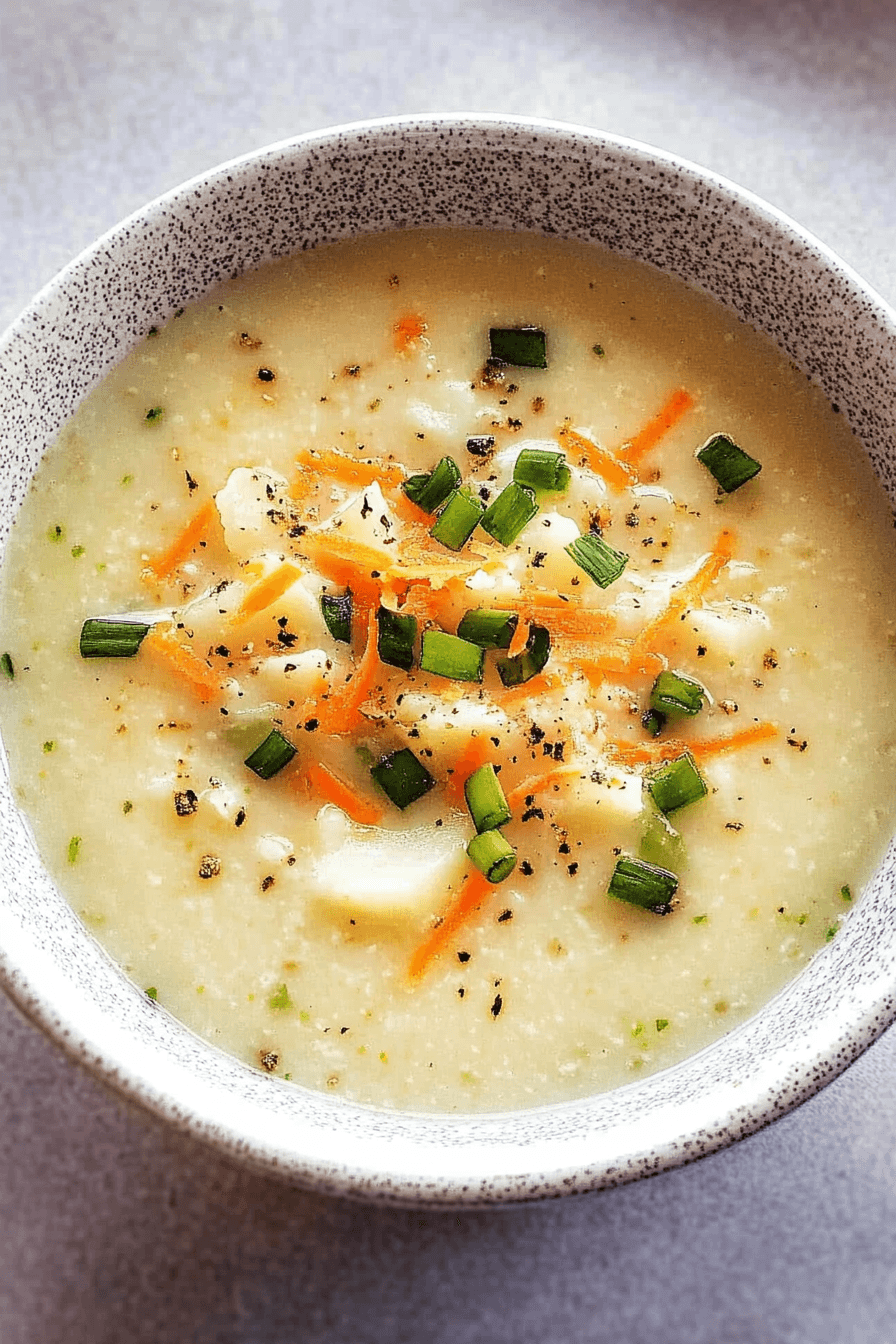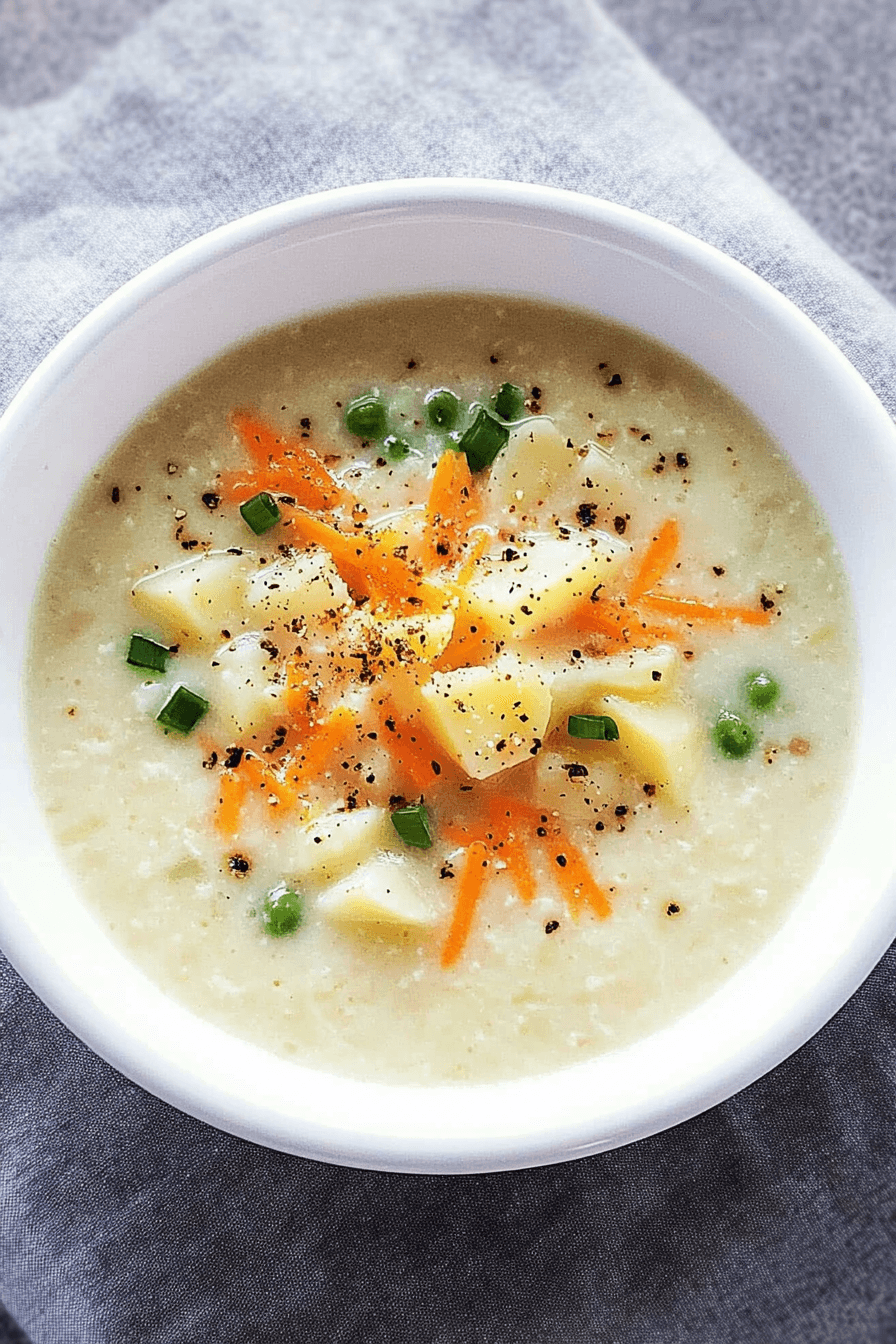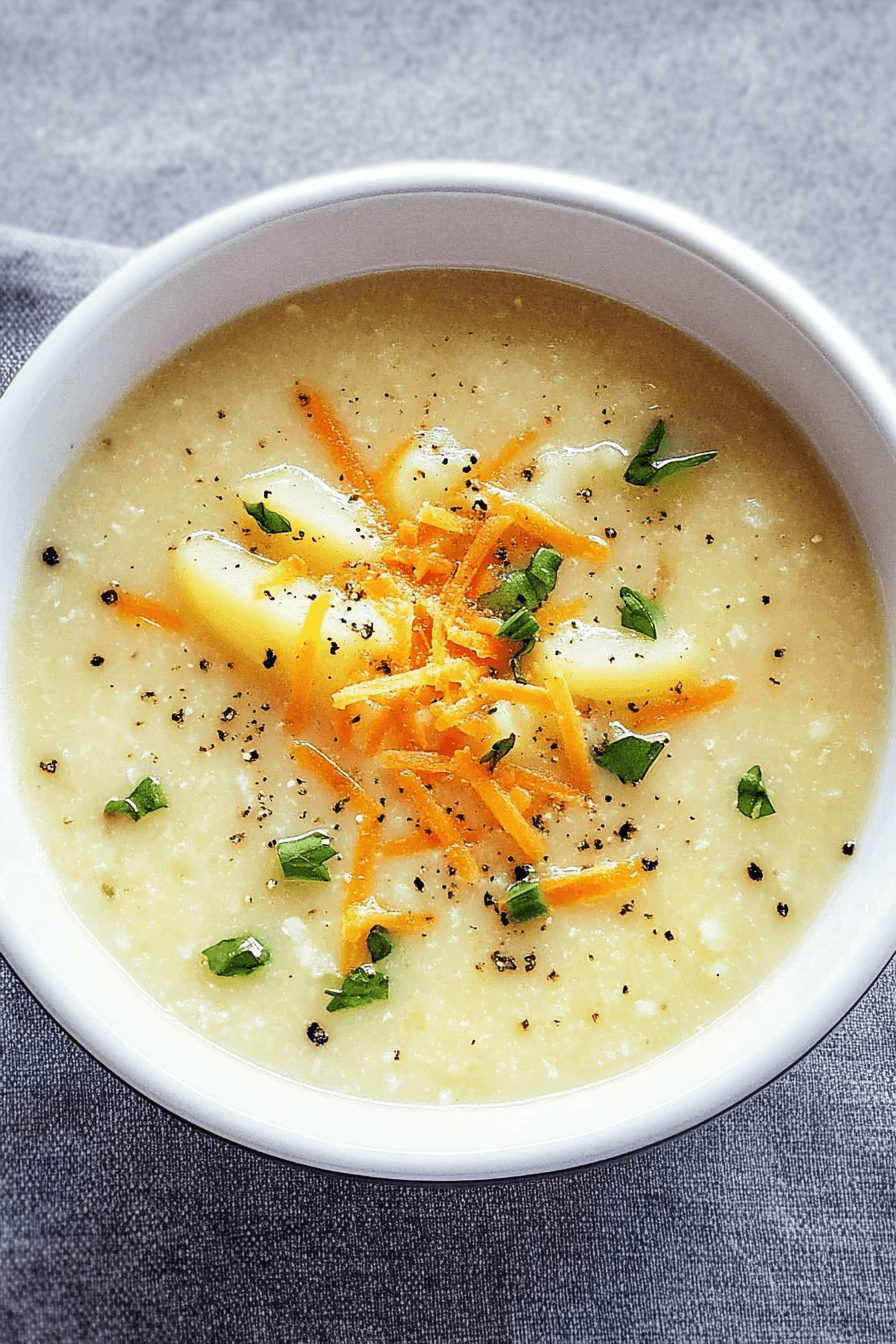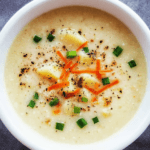Introduction to Potato Soup
Potato soup is a comforting classic that graces tables with warmth and nourishment. Perfect for busy parents and home cooks alike, this dish is both simple and wholesome. The velvety contrast of creamy potatoes mingled with savory spices makes every spoonful a treat. Whether you’re a busy professional seeking to streamline dinner or a food enthusiast eager to try your hand at a robust soup night, potato soup is a versatile recipe. Its ease and adaptability never fail to impress, fitting dietary preferences across the board.Benefits and Advantages of Potato Soup
Potato soup stands out for its ease of preparation and delicious versatility, appealing to a broad range of individuals. This recipe excels with its minimal hands-on time, making it an excellent choice for busy schedules. Additionally, by using readily available vegetables and low-fat dairy, it transforms into a nutritious option without losing its creamy texture.One can adjust the ingredients effortlessly to accommodate vegan, vegetarian, or gluten-free preferences, ensuring everyone gets a taste of this delight. Furthermore, potato soup is a perfect candidate for meal prep as it stores well, offering lasting convenience for work lunches or quick dinners. By incorporating local produce and spices, it also attains a delightful punch that celebrates global culinary influences, fostering memorable meals with each spoonful.
Ingredients Overview
Essential Ingredients for Potato Soup
- Potatoes: 4 large russet potatoes, peeled and cubed. These are the star of the dish, providing a creamy texture.
- Milk or Cream: 2 cups of whole milk or heavy cream. Choose based on desired richness.
- Onions: 1 medium onion, finely chopped. It adds a sweet depth to the flavor.
- Chicken Broth: 4 cups for a savory base; use vegetable broth for a vegetarian option.
- Celery: 2 stalks, diced. Adds a nice crunch and flavor.
- Butter: 2 tablespoons to sauté the vegetables and enhance richness.
- Cheese: 1 cup of shredded cheddar, if desired, for a cheesy finish.
- Bacon: 4 slices, cooked and crumbled, adding an optional smoky flavor.
- Chives: Fresh or dried, as a garnish for added color and mild onion flavor.
- Garlic: 2 cloves, minced, to boost the savory notes.
- Salt and Pepper: To taste, for seasoning.
Dietary Substitutions to Customize Your Potato Soup
For those who have specific dietary preferences or needs, there are various substitutions to adapt the potato soup recipe:
- Vegan Option: Use plant-based milk such as almond milk and replace butter with olive oil. Opt for vegetable broth instead of chicken broth.
- Gluten-Free Thickener: Replace traditional flour with cornstarch or rice flour to ensure the soup remains gluten-free.
- Low-Calorie Swap: Consider using low-fat milk and reduce or eliminate cheese and bacon. You can also add more vegetables such as carrots or spinach.
- Vegetarian Version: Stick with vegetable broth and forego bacon entirely, or use a vegan bacon alternative.
These substitutions ensure that your potato soup can cater to diverse culinary preferences while still maintaining its signature comforting flavors.
How to Prepare the Perfect Potato Soup: Step-by-Step Guide
Creating a flavorful and creamy bowl of potato soup is straightforward and rewarding. Follow the steps below for a seamless culinary experience:
First Step: Sauté the Vegetables
Begin by melting the butter in a large pot over medium heat. Add the chopped onions, minced garlic, and diced celery to the pot. Stir frequently until the vegetables are soft and fragrant, which should take about 5-7 minutes.
Second Step: Cook the Potatoes
Introduce the cubed potatoes to the pot, followed by the chicken or vegetable broth. Increase the heat to high and bring the mixture to a boil. Once boiling, reduce the heat to low and cover the pot. Allow the potatoes to simmer until tender, about 20 minutes.
Third Step: Blend for Creaminess
Remove the pot from heat and carefully blend the soup using an immersion blender until smooth and creamy. Alternatively, transfer the soup in batches to a countertop blender. Return the soup to the pot.
Fourth Step: Add Milk and Season
Slowly stir in the milk or cream, adding salt and pepper to taste. Continue to heat the soup on low, allowing the flavors to merge. If desired, this is the time to add shredded cheese for extra creaminess.
Fifth Step: Incorporate Toppings
Before serving, sprinkle the crumbled bacon and chives over the soup for added texture and flavor. Customize with your favorite toppings, such as a dash of hot sauce or a dollop of sour cream.
With these straightforward steps, you will have a hearty and delicious potato soup perfect for any gathering or cozy family dinner.

Mastering Potato Soup: Advanced Tips and Variations
Crafting the perfect potato soup doesn’t stop with just following a recipe; it’s an art that allows for creativity and personal flair. As you grow more comfortable making this classic dish, consider the following advanced tips and variations to truly master your potato soup
Using Herbs and Spices
One of the simplest ways to add depth to your potato soup is by experimenting with herbs and spices. Fresh thyme or rosemary can lend a fragrant touch, while a sprinkle of nutmeg or paprika adds a unique warmth to the soup.
- Thyme: Fresh or dried thyme can enhance the earthy flavor of the potatoes.
- Rosemary: Just a sprig or two can add rich aromas and a peppery hint.
- Paprika: Choose smoked paprika for a subtle, smoky note.
Texture and Consistency
The texture of your soup can be adjusted based on your preference. Some enjoy a thick, hearty consistency, while others might prefer a lighter broth.
- For a creamy texture: Use heavy cream or a combination of sour cream for a silkier finish.
- For a thinned version: Add more broth or incorporate a vegetal stock for enhanced flavor.
Exciting Flavor Combinations
Don’t be afraid to introduce new ingredients and flavor profiles into your potato soup. Incorporating ingredients like leeks, garlic, or even a splash of sherry can bring exciting dimensions to your dish.
- Leeks: Their mild onion flavor pairs beautifully with potatoes.
- Garlic: Whether roasted or fresh, garlic adds a robust layer of taste.
- Cheese Infusion: Stir in shredded cheddar or parmesan for a cheesy delight.
Continue to experiment, and you’ll soon find yourself crafting a signature potato soup that could rival classic potato dishes or unique pasta recipes.
How to Store Potato Soup: Best Practices
Preserving the taste and texture of your potato soup is crucial, whether you’re preparing it ahead or storing leftovers. Here’s how to keep your soup fresh and delicious.
Refrigeration Tips
If you plan to consume your soup within a few days, refrigeration is your best option. Allow the soup to cool to room temperature before transferring it to an airtight container. Store it in the fridge where it can last for up to four days.
Freezing the Soup
For longer storage, potato soup can be frozen. However, be cautious as the texture of the potatoes can change once thawed. For best results, avoid freezing soups with dairy. If your recipe does include cream, consider adding it after thawing.
Reheating Instructions
When ready to enjoy your potato soup, reheating can be done on the stovetop or in the microwave. For stovetop reheating, use a low heat setting to avoid separating the cream or overcooking the potatoes.
- Stovetop: Stir occasionally over low heat until warmed thoroughly.
- Microwave: Use a microwave-safe bowl, heating on medium power in short intervals, stirring in between.
Being attentive to these storage methods ensures your potato soup remains as satisfying as it was fresh, allowing you to enjoy a warm meal at your convenience. Check out more insights on effective food storage methods.

Nutritional Value of Potato Soup
Understanding the nutritional profile of potato soup can help you make informed dietary choices, allowing for a balance of indulgence and nutrition. Typically, a standard serving of potato soup, which is approximately one cup, contains about 200-250 calories. However, this number can vary significantly depending on the ingredients used, especially when considering creamy additions or toppings like cheese and bacon.
- Calories: 200 – 250 per serving
- Fat: 15 – 20 grams, largely influenced by the use of cream, butter, and bacon
- Carbohydrates: 20 – 25 grams, primarily from potatoes
- Protein: 5 – 10 grams, which can be increased with toppings like bacon or cheese
- Sodium: 500 – 900 milligrams, dependent on broth and seasoning choices
- Fiber: 2 – 3 grams, mostly found in potatoes and any additional vegetables included
For those watching their diet, potato soup can be adjusted for health benefits. Opting for low-fat milk or broth can significantly reduce the fat content. To make it even healthier, you might consider incorporating more vegetables like carrots or celery, ensuring a broader range of nutrients and increasing fiber intake. Additionally, using a vegetable broth instead of chicken broth can cater to a vegetarian diet without sacrificing flavor.
FAQs: Frequently Asked Questions About Potato Soup
What type of potatoes are best for making potato soup?
For the creamiest potato soup, Yukon Gold potatoes are generally recommended because they have a buttery texture that blends well into the soup. Alternatively, Russet potatoes are popular due to their high starch content, which helps thicken the soup naturally.
Do I need to peel the potatoes for potato soup?
Peeling the potatoes is optional. Leaving the skins on can add extra texture and nutrients, but peeling can result in a smoother consistency if preferred. Additionally, the choice often depends on the type of potatoes used; thinner-skinned potatoes may not require peeling.
How do I thicken potato soup if it’s too thin?
If your potato soup turns out too thin, you can thicken it by a few methods: add a slurry of cornstarch and cool broth, blend some of the soup to make it creamier, or incorporate more cooked potatoes. Be sure to let the soup simmer for a few minutes after adding any thickeners.
Can potato soup be made in a slow cooker?
Yes, potato soup can be effectively prepared in a slow cooker. Simply combine all the ingredients except milk or cream and let it cook on low heat for 6-8 hours. Stir in the dairy towards the end to prevent curdling, ensuring the soup remains creamy.
For more detailed potato recipes and inspiration, explore resources like the U.S. Potatoes website. It’s a fantastic place for finding creative ideas and methods to adapt homemade favorites like potato soup.
Print
Potato Soup Recipe Perfect
- Total Time: 45 minutes
Description
🥣 Warm, creamy, and packed with flavor, this homemade potato soup is the ultimate comfort food for chilly days! ❄️✨
🧀 With rich ingredients like cheese, bacon, and buttery potatoes, it’s a deliciously satisfying meal that can be customized to your taste! 🥔🔥
Ingredients
Potatoes
Onion
Garlic
Butter
Chicken broth (or vegetable broth for vegetarian option)
Milk (or cream for a richer texture)
Celery
Cheese (cheddar or preferred type)
Bacon (optional)
Chives
Salt
Black pepper
Thyme (optional)
Carrots (optional)
Corn starch or rice flour (for gluten-free thickening)
Bread or crackers (for serving)
Instructions
1. Peel and dice the potatoes into small cubes.
2. Chop the onions, celery, and any other vegetables you want to include.
3. In a large pot, melt butter over medium heat.
4. Add the chopped onions, celery, and garlic, then sauté until softened.
5. Pour in chicken or vegetable broth and bring to a boil.
6. Add the diced potatoes and reduce heat to a simmer.
7. Cook until the potatoes are tender, about 15-20 minutes.
8. Use a potato masher or blender to partially blend the soup for a creamier texture.
9. Stir in milk or cream and continue cooking on low heat.
10. Add salt, pepper, and any other seasonings to taste.
11. If using cheese, stir it in until melted and well combined.
12. For extra thickness, mix a small amount of cornstarch with water and add to the soup.
13. Cook for a few more minutes until the soup thickens.
14. Fry or bake bacon until crispy, then crumble into small pieces.
15. Serve hot and garnish with bacon bits, chives, and additional cheese if desired.
16. Pair with bread or crackers for a complete meal.
17. Store leftovers in an airtight container in the refrigerator for up to 3-4 days.
18. Reheat gently on the stovetop, adding more broth or milk if needed.
19. Adjust flavors before serving by adding more seasoning if necessary.
20. Enjoy your homemade potato soup!
Notes
Add more nutrition by incorporating extra vegetables like carrots or celery, which blend well with the soup while boosting fiber and vitamins.
For a lighter version, swap out heavy cream for low-fat milk and reduce the cheese and bacon to lower the fat and calorie content.
To keep the flavor rich while controlling sodium, use low-sodium broth and season with herbs and garlic instead of relying on salt.
- Prep Time: 15
- Cook Time: 30
- Category: Soup
- Method: Boiling
- Cuisine: Various (commonly American or European)

